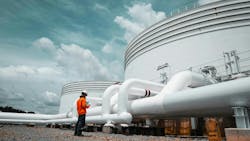Energy Saver: The Plant Walkthrough Energy Audit
It’s critical to walk through the plant at your own pace and agenda.
Conducting regular walkthrough audits of industrial plants is an effective way to identify low-cost or no-cost energy efficiency opportunities. A trained energy consultant or a mechanical engineer can observe operational practices, inspect equipment and detect inefficiencies simply by walking the process units together with the operating staff.
I have done over 50 walkthroughs of refineries and petrochemical plants in my career. As part of the energy efficiency program, it’s always recommended to look at the process units and the equipment in person and take note of situations and operations that may lead to energy waste. For these audits, I take the following with me:
- Proper personal protection equipment (PPE) as required by the site, including a gas/H2S detector;
- Small notebook and pencil;
- Compact camera (cell phones are typically not allowed);
- An infrared laser point thermometer or, even better, a thermal imaging camera. The thermal imaging camera will provide better temperature profiles of larger pieces of equipment.
I normally do these walkthroughs after a full review of the processes, in which I discuss operational data and limitations with the operators and engineers. It’s critical to walk through the unit at my own pace and agenda, as a client-guided tour (sometimes by car only) will not provide the information I seek. Let me summarize some typical units and process equipment that I observe.
Stable Operation and Process Control
Ideally, the plant operates under stable conditions with constant feed rates, compositions, product specs and utilities. Variation requires operators to spend more time adjusting rather than optimizing efficiency. I ask questions about stability and potential savings from improvements. Better stability, besides energy, also improves yields. A visit to the control room and a discussion with some of the control operators will give great insight into how they keep operations stable and any constraints they experience.
Insulation Inspection and Repair
The condition, completeness and integrity of insulation on piping, vessels, exchangers and refrigeration equipment should be assessed. Deteriorated or missing insulation wastes energy and risks corrosion under the insulation. Insulation surveys can identify repair and replacement needs. Insulation should also cover lesser items such as flanges, valves, steam turbines and exchanger heads. A good indicator of effective insulation is to look at the operating data during a rainstorm. Typically, rain will cause an increase in steam and fuel consumption and can indicate insulation efficiency. Also, an energy balance between winter and summer operation of the plant may offer the same information.
Steam System Leaks and Maintenance
Steam leaks represent wasted boiler fuel and increase as leaks progress. Shutdowns may sometimes be needed for repairs. Temporary fixes like sealed clamps can reduce losses until permanent repairs can happen. Steam trap surveys and preventive maintenance programs are also important to optimize steam systems. When you see a steam plume during daytime (around 75° F outside temperature), steam waste in pounds per hour can be determined by taking the length of the steam plume (in ft) squared times four. So, a 3 ft steam plume calculated as 32 x 4 will waste about 36 lb/h of steam.
Rotating Equipment Inspection
Centrifugal pumps, fans, compressors and turbines should be checked for operational issues like bearing wear, filter fouling, leaks, throttling valves and optimization potential from minor retrofits. Speed reduction on turbine-driven equipment may save energy if process control permits. Steam turbines on standby should not be slow rolling, as that can consume up to 30% of the steam without providing any shaft power. Centrifugal compressors use excess power when anti-surge systems operate unnecessarily. Recycle flow rates indicate potential for energy reduction. Specialist support may be required including optimization and software retrofits.
Fired Heaters
Fired heater efficiency and best practices heaters require proper combustion air ratios, minimized air leaks, clean air preheaters, optimized firing rates and regular cleaning of convection sections. Infrared surveys document refractory faults during operation, and the thermal imaging camera provides good service there. Best practices aim to fire at peak efficiency while avoiding flame impingement. Typically, I aim for an oxygen percentage of 2% in the stack to maximize the heater efficiency.
Air Cooled Heat Exchanger Inspection
Tube bundles, air distribution, fans, belts, seals and insulation on air-cooled exchangers impact performance. Cleaning programs counteract fouling impacts. Airflow assessments identify opportunities like removing inlet insulation or fitting low-cost device improvements like seal disks and tip seals for the fans. Another check is to look upward from under tube bundles and if no daylight is sparking through, the finned tubes may need to be washed externally. This typically can be done while the unit is in operation.
Cooling Tower System Optimization
Cooling tower distribution lines, packs, water treatment and operation influence achievable temperature approaches. It’s critical that each cooling tower cell has an equal distribution of water flowing down. Air leaks at damaged cells or access points reduce performance and efficiency. Pumping sets require regular checks for symmetry. The performance of the cooling towers and their contribution to energy efficiency is often undervalued. However, the efficiency of many turbines (condensing types) and compressors depends on these. Maintenance and inspection should be planned every year during the colder winter months.
Controls and Software Upgrades
Old or non-automatic controls on rotating equipment fail to protect machinery or optimize for part loads. System-wide optimization software smartly coordinates multiple drivers, including both electrical motors and steam turbines. Controls upgrades realize efficiency benefits. These system optimizations may include advanced controls or utility system optimizers. A utility system optimizer will continuously review energy demand and operate the energy supply system in the most efficient way.
Potential Projects and Reporting
The audit guide highlights the observation notes and photos and provide context for potential energy improvement projects. Pre- and post-visit communications set expectations, while a short presentation of key findings after the walkthrough provides takeaways and opportunities that can be implemented instantly. A detailed report will cross-reference observations to opportunities and calculations. In addition, a color-coded scoring card per plant visually summarizes major inspection topics and compares the performance between individual process units.
In summary, the walkthrough audit approach provides a structured means to visually inspect chemical plants and oil refineries and identify low-hanging efficiency opportunities simply through touring and observing equipment with operating staff, applying best practices and consultants in recognizing issues across common equipment types and facility-wide systems. The resultant presentation, walkthrough report, photographs and scoring cards, communicate the findings to stakeholders and can support and prioritize investment in projects.
About the Author
Michiel Spoor, Energy Saver columnist
Energy Saver columnist
Michiel Spoor has over 28 years of energy experience, working worldwide as a leader in oil and gas consulting. He has a master’s degree in Chemical Process Technology from the Delft University of Technology in The Netherlands.
His passion is to shape the future of energy transition, renewables, global carbon emission reduction and energy efficiency. He has had diverse roles in engineering and consulting. He started his career as a process design engineer at Badger BV in The Hague where he brought plants from conceptual design, through process simulation, equipment designs all the way to commissioning and start-up.
As a consultant Michiel specializes in energy management and energy transition and has held senior positions in various companies like KBC, Accenture and KBR. Currently Michiel works as a Principal Consultant Energy with KBC Advanced Technology in Houston, Texas. He has worked on six continents on various projects and positions in oil refining, petrochemicals, fertilizers, LNG and renewables.
Michiel has authored and contributed to numerous papers and conferences on the topics of refinery energy efficiency and refinery carbon management. He is internationally recognized as an authority on this subject.

